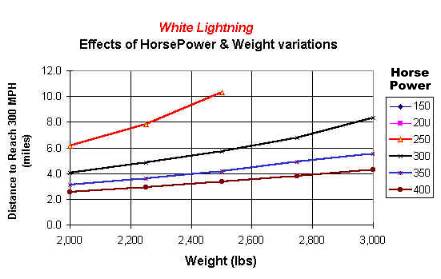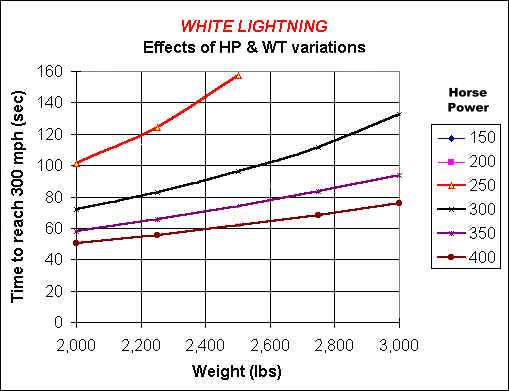Sensitivity Studies
Comparative plots are especially useful for sensitivity studies.
What happens if we only have 375 Horsepower instead of 400 Horsepower available? Or 425
Horsepower? What happens if we save 200 pounds of weight? Or if the actual vehicle ends up
weighing 3,000 pounds instead of the desired 2,500 pounds. Are such changes super
important or irrelevant?
WE make the computer runs, plot the data into pretty graphs and immediately can SEE
how sensitive our 300 MPH goal is to variations in these different
inputs. It's FUN!

First thing we notice is that the lower 150
and 200 Horsepower data lines aren't even on the plots. All this tells us is that WHITE
LIGHTNING will never reach 300 MPH if all we have is 150 or 200
Horsepower.
If we assume 400 Horsepower is available, we can readily see that the time it would take
the vehicle to reach 300 MPH would only be 50 seconds - if the car weighed 2,000 pounds,
but would take 76 seconds - if it weighed a heavier 3,000 pounds. Also note the 2,000
pound, 400 Horsepower car would reach 300 MPH in about 2.6 miles, whereas a 3,000 pound
version would take 4.3 Miles.
The plots also tell us interesting things like "If WHITE LIGHTNING weighed 3,000 pounds, but only had 300 Horsepower available, it
could still reach 300 MPH, but it sure couldn't set that record at the Bonneville
Salt Flats". That is because at its best, the Bonneville Long Track only has 8 miles
available. Don't forget, in order to set an official record, the vehicle must get up to
speed, go through the measured timed mile/kilometer traps AND get safely slowed
down and stopped before running out of smooth race course. Then, within an hour a
backup run in the opposite direction must be completed. Thus, the maximum distance
(subtracting out the measured mile in the center of the course) the vehicle has to build
up speed in is 3.5 miles.
What all drivers really do is enter the timing traps as fast as they can and keep
accelerating all the way through the measured mile/kilometer in order to get a little
better "measured average speed" which is found by dividing the known
precise "distance" setup between the timing clocks by the accurately
measured "total time" to cover that distance.

or go back to

